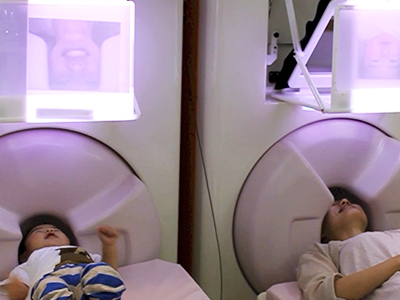Abstract:
Special activities in the brains have been discovered while a child with autism spectrum disorder and the mother are gazing each other by the utilization of special equipment based on magnetoencephalography applicable to both child and mother simultaneously. Since bidirectional interactions of mother and child are thought to play important roles in the development of child’s sociality, the current study is thought to be a big step to elucidation of development of child’s social brain.
Special activities in the brains while mother and her child with autism spectrum disorder are gazing each other have been discovered by the research team of Kanazawa University together with the research team of Osaka University. The teams used a very special equipment based on magnetoencephalography (MEG) to make three scientifically important discoveries.
1. Brain activities upon gazing each other are low in the case of child with serious autism spectrum disorder.
2. While the activities in child’s brain with autism spectrum disorder are low, the activities in mother’s brain are also low.
3. When mother makes a movement such as nodding in response to her child, the activities in mother’s brain are high.
This study was able to be performed thanks to the equipment development. MEG can detect electrical activities of the brain in a non-invasive and hence non-harmful manner, by the utilization of superconducting sensor technology, with very high time and space resolutions. The researchers have developed an MEG for a child (only one copy in Japan). Furthermore, a very special equipment has been constructed, based on the MEG for a child as above, which can be used for an adult and a child simultaneously, the equipment available only in Kanazawa in the world.
While a parent and a child are gazing each other, enormous amounts of social information are exchanged in an unconscious manner. That is, reading of the face allows new emotion to emerge, which appears on your own face and affects the other; these interactions continue without cease. Bidirectional interactions are thought to play important roles in the development of child’s sociality.
Simultaneous measurements of brain activities while mother and child are gazing each other by the current study are expected to be a big step to elucidation of development of child’s social brain.
The article describing the research results was published online in Scientific Reports, an American journal, on Oct. 10, 2016.

[Simultaneous Measurements of Brain Activities with MEG] The special MEG used in this study can detect electrical activities of the brain of an adult and that of a child. (The child in this picture does not suffer from autism spectrum disorder.)
Article
Title: Mu rhythm suppression reflects mother-child face-to-face interactions: a pilot study with MEG simultaneous recording
Journal: Scientific Reports 6, article number: 34977 (2016)
Authors: Chiaki HASEGAWA1, Takashi IKEDA2, Yuko YOSHIMURA1, Hirotoshi HIRAISHI1, Tetsuya TAKAHASHI1, Naoki FURUTANI1, Norio HAYASHI3, Yoshio MINABE1, Masayuki HIRATA2, Minoru ASADA2, Mitsuru KIKUCHI1
Doi: 10.1038/srep34977
Funder
Ministry of Education, Culture, Sports, Science and Technology of Japan, Japan Society for the Promotion of Science, Japan Science and Technology Agency



 PAGE TOP
PAGE TOP